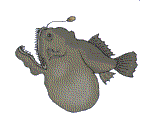
By Russell Odell
Would you believe this if you read it in the Bible?
I had trouble believing in the virgin birth of Christ. It is an unusual birth. However, if you study nature you will find there are many spectacular and unbelievable births, one more bewildering than the other. Even Einstein believed in a Creator. I will start with the premise that there is a Creator in the scheme of things. I think it is reasonable to have this thought in mind because the last words of knowledge have yet to be written. We still have much to consider and learn.
One of the most bizarre mating I have ever read is described in
Steve Parker's book, Ocean Life, on page 73.

When a male deep sea anglerfish finds a female, he bites her--and never lets go! His mouth grows into her skin, his body merges into hers and he becomes part of the female. Almost all of his internal organs disappear, apart from the testes which are needed for breeding. The male spends the rest of his life as a shrunken parasite on his mate, useful only for providing the sperm which fertilizes her eggs at breeding time.This is a scientific fact, not just a theory. After reading this, I wonder how many would believe this if they read it in Genesis? Maybe we would be inclined to say it was a biblical myth. Such things do not happen. But, the author of this book gained First Class Honors in Zoology, then worked as an exhibition scientist at London's Natural History Museum. He became a full time writer and editor in 1984 and has written several books. And what he wrote about the mating of the male deep sea anglerfish is a true scientific fact.

Another strange birthing is found with the little sea horse, an ocean fish measuring from two to fourteen inches. The male, not the female, gets pregnant and gives birth to the offspring by the hundreds! There are 35 species of sea horses and their size varies. They swim vertically by beating their dorsal fin 70 times a second (the hummingbird beats its wings about the same frequency). David Attenborough writes in his book The Trial of Life, on page 26:
Three or four days before mating, the male develops a pouch on his belly. The female squirts several thousand eggs into his pouch in about five seconds. The male then dumps his sperm into the pouch and the eggs become fertilized. In about two weeks, the male gives birth to more than a thousand babies.If you read this in the creation story of Genesis that a male becomes pregnant and gives birth to more than a thousand babies, would you believe it? Of course not. Who ever heard of a male of any species becoming pregnant? But this is a scientific fact, not a theory.
The oyster is one of the 15,000 species of mollusks. Oysters attached themselves to rocks where they live for 10-15 years.
The male of the American-Canadian species releases his sperm into the water. The female then releases her eggs. As the eggs float by and through the sperm they become fertilized. This contact between the egg and the sperm is purely a chance happening. Thousands of eggs never make contact. If the water is cool, the fertilized eggs will hatch in 10 to 12 hours. If the water is warm they will hatch in 5 to 6 hours.
The European oyster has a similar method but it is a little different. The male releases his sperm into the water. When the female oyster senses the sperm, she draws it into her shell. Here it fertilizes the eggs. The fertilized eggs are then released into the water. If you read these two accounts of how the oyster propagates itself in the Bible, would you believe this kind of a story? I would not. It sounds too mythological. Sperm and eggs floating out into the water and coming together? The male and female oyster never touching each other? You will note that the female oyster always remains a virgin! Hard to believe, isn't it? However, you can read about it in Jacques Cousteau's book, The Ocean World. It's a fact, not a theory. Here is undoubted proof that virgin births do happen.
Creatures that can change their sex is another mystery of the unknown. It is a common occurrence in nature. However, you will not read about such a miracle in Genesis. If you did, you would not believe it anyway. The clown fish that lives amongst the poisonous tentacles of the anemones is one of the fish species that can change their sex. If the breeding female dies, the partner changes his sex, becomes a female and mates with another male. Sounds like a scientific myth, doesn't it? Just a fairy-tale? No, it is a fact, not a myth. Do you still doubt the virgin birth of Christ? Why? It happens in nature every day.
More spectacular are some of the species of the lizards that can give birth to young without mating with a male. Remember, if the male is not involved we have a virgin birth. Attenborough writes on page 288 of the same quoted book:
At least twenty-seven species belonging to seven different families exist mostly, if not entirely, as females. None of these individuals, however, can reproduce herself if in solitude. Each needs the encouragement and stimulation of another female, who plays the part of the courting male. Such a pseudo-male will later, with the help of another companion, produce her own clutch. (It is a type of parthenogenesis. Would you believe this if you read it in the Bible? Be honest--would you?)Now we come to a strange phenomenon called parthenogenesis. It was discovered by Charles Bonnet (1720-1793) a Swiss entomologist. He discovered that the infertile eggs of some insects, like the aphids and the bee would hatch. From the Encyclopedia of Insects and Arachnids by Maurice and Robert Button, pages 13 and 14, we can read of the parthenogenesis birth of the aphid. This tiny garden pest propagates without the male. Not only are babies born of virgin mothers, they are born pregnant! Would you believe this if you read it in Genesis? The Buttons write:
A single parthenogenic female, with her offsprings, could produce in a year, if they all survived, a weight equal to 500,000,000 stout men. (That number is the figure 5, followed by 8 zeros.)I will close by telling you a little about the hermaphroditism mode of reproduction. If you think the foregoing methods of reproduction were different from the norm, hermaphroditism will blow your mind. I will take this directly from Jacques Cousteau's book, The Ocean World, page 26:
Hermaphroditism is the condition which an individual animal posses the reproduction organs of both sexes. It can increase the reproductive potential of a species, since eggs are produced by all the individuals instead of only half, as in the case in species with separate sexes. Also, in solitary or rare species it guarantees that whenever two individuals meet, mating can take place, because each individual has both sperm and eggs.Cousteau continues with:
Hermaphroditism is the normal mode of reproduction in many animals. For instance, the sea hare is a marine snail without a shell. At mating time one sea hare climbs on the back of another. Both face the same direction with the one behind fertilizing the eggs of the one in front. A third may mount the second so that its eggs are being fertilized while it is supplying sperm to the sea hare in front. In this manner long chains of mating individuals may form. Sometimes the first individual will swing around and mount the last so that the circle is closed. All the mating animals are thus simultaneously fertilizing the eggs plus being fertilized themselves. Some species do not rely on locating others of their species. They are capable of using their sperm to fertilize their own eggs.Read that last sentence again! Such a birthing procedure excels all others. Would you believe this if you read it in the Bible? However, this is a scientific fact, not a myth or a theory.
I wonder why the clergy does not point out these simple scientific facts of the handiworks of the Creator to their followers (Job 37:14). The virgin birth of Christ would be easier to accept because virgin births happen in nature thousands of times a day. I think the comparisons are noteworthy. It shows the diversity of the Creator's power. It exemplifies Job 37:14, "Stand still, O Job, and behold the wondrous works of God."
God gave us a brain to think with because He knew we were going to be a curious creature. We would want to know a lot about the whats, the whys, and the wherefores and we would not be too ready to accept just any answers. There would have to be some strong examples for us to get a grasp on. Can such a thing really happen? Now that we know that they do are we going to remain ignorant of the wondrous works of God? I think not. The possibilities of the happenings are too numerous and with such pronounced evidence that we can no longer deny them.
Back to Contents Does God Exist?, SepOct01.